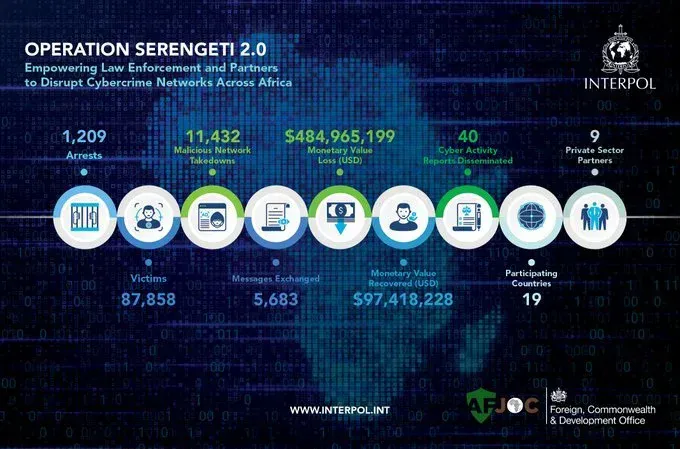The Global Cybercrime Empire: Mapping the Underground Economy, Partnerships, and Geopolitical Power Structures

Bottom Line: Cybercrime has evolved into a $10.5 trillion global economy dominated by sophisticated nation-state actors, ransomware cartels, and hybrid criminal-state partnerships. Four nations—Russia, China, Iran, and North Korea—control 77% of all state-sponsored cyber operations, while criminal organizations have formed unprecedented alliances, creating a complex web of affiliations that spans continents. This ecosystem operates like a multinational corporation, complete with specialized departments, franchise models, and strategic partnerships that challenge traditional law enforcement approaches.
Introduction: The $10.5 Trillion Shadow Economy
By 2025, cybercrime has become the world's third-largest economy, behind only the United States and China. Global cybercrime damages are projected to reach $10.5 trillion annually by 2025, growing from $3 trillion in 2015—representing the greatest transfer of economic wealth in history. This isn't just about isolated hackers in basements; it's about organized criminal enterprises that rival the sophistication of legitimate multinational corporations.

The modern cybercrime ecosystem operates with:
- Hierarchical command structures similar to traditional organized crime
- Franchise business models through Ransomware-as-a-Service (RaaS) operations
- Strategic partnerships between criminal groups and nation-states
- Supply chain relationships connecting initial access brokers, malware developers, money launderers, and enforcement services
- Geographic safe havens where operations can flourish with state protection or tolerance
The Big Five: Nation-State Cyber Powers
Since 2005, thirty-four countries are suspected of sponsoring cyber operations. China, Russia, Iran, and North Korea sponsored 77 percent of all suspected operations, but this statistic focuses on adversarial operations. When including allied cyber powers, the "Big Five" cyber nations dominate global cyberspace: the United States, Russia, China, Iran, and North Korea.
The United States: The Silent Giant
The Difference: Unlike adversarial nations that often conduct disruptive attacks for political gain, the US primarily focuses on intelligence collection, counterterrorism, and defensive operations. Most US cyber operations remain classified and unattributed.
Key Organizations:
- NSA Tailored Access Operations (TAO): Now called Computer Network Operations (CNO), this is arguably the world's most sophisticated cyber unit with over 1,000 elite hackers, analysts, and engineers
- US Cyber Command (USCYBERCOM): Military cyber operations with $13.5 billion budget for cyberspace activities
- CIA cyber division: Conducts covert cyber operations overseas
- FBI cyber division: Domestic cybercrime investigation and disruption
Documented Capabilities (from Snowden leaks and other revelations):
- ANT Catalog: 50-page classified document listing advanced hacking tools for routers, switches, and firewalls
- QUANTUM attacks: Man-in-the-middle attacks using global server networks
- Supply chain interdiction: Intercepting and backdooring hardware shipments to targets
- Zero-day exploitation: Advanced persistent access to foreign networks
- PRISM program: Direct access to major tech company data

Notable Operations (publicly revealed):
- Stuxnet (2010): Joint US-Israel operation that physically damaged Iranian nuclear centrifuges
- Chinese PLA hacking (ongoing): TAO has "successfully penetrated Chinese computer and telecommunications systems for almost 15 years"
- Huawei infiltration: NSA operation to gather intelligence about Huawei products and prove military ties
- Belgian Telecom (Belgacom): Joint operation with UK's GCHQ compromising major European telecom
- Syrian internet blackout (2012): NSA operation that disconnected Syria from internet for three days
Current Status:
- The U.S. government has formally paused offensive cyber operations against Russia as of February 2025
- Focus shifted to defending against Salt Typhoon (Chinese APT) which breached almost every major US telecom company
- Massive $13.5 billion cyberspace activities budget for 2024
Why the US Doesn't "Take Credit":
- Intelligence Value: Maintaining plausible deniability preserves ongoing access to intelligence targets
- Diplomatic Relations: Avoiding attribution prevents diplomatic incidents with allies
- Legal Framework: Many operations occur under classified authorities that can't be publicly acknowledged
- Defensive Posture: The US positions itself as defending against adversaries rather than as an aggressor
- Five Eyes Cooperation: Many operations involve allied intelligence agencies and can't be unilaterally disclosed
Russia: The Cybercrime Capital
Geopolitical Position: Russia operates the most complex and permissive cybercrime ecosystem in the world, where state intelligence services, criminal enterprises, and "patriotic hackers" create a blurred line between official and unofficial operations.
Key State Actors:
- GRU (Military Intelligence): Operates Fancy Bear (APT28/Sofacy Group) and Sandworm (APT44/Telebots)
- FSB (Federal Security Service): Runs domestic and international cyber operations
- SVR (Foreign Intelligence): Conducts long-term espionage campaigns
Major Criminal Groups:
- LockBit: The world's most prolific ransomware operation, responsible for 44% of all ransomware incidents globally as of 2023
- MUMMY SPIDER: Creators and operators of the Emotet botnet
- Wizard Spider: Linked to Ryuk and Conti ransomware operations
- Twisted Spider: Associated with Maze and Egregor ransomware
The Russian Model: Russia's cyber strategy relies on "information confrontation"—integrating cyber operations, psychological warfare, electronic warfare, and traditional military operations. Russian-speaking cybercriminals dominate the global ransomware industry, with an estimated 75% of ransomware revenue going to actors linked to the Russian-language underground.
2024-2025 Activities:
- Russian cyberattacks on Ukraine surged by nearly 70% in 2024, with 4,315 incidents targeting critical infrastructure
- Russia was the most common source of malicious traffic on the global Internet, accounting for about 16% of all recorded attacks in 2024

China: The Strategic Intelligence Machine
Geopolitical Position: China operates the most systematic and strategically focused cyber program, primarily aimed at intellectual property theft, military intelligence, and technological advancement.
Key State Actors:
- APT41 (WICKED PANDA): Dual-purpose group conducting both espionage and cybercrime
- APT1 (Comment Crew/PLA Unit 61398): Military-affiliated group focused on industrial espionage
- MSS-affiliated groups: Multiple Advanced Persistent Threat groups serving China's Ministry of State Security
Strategic Focus:
- Chinese cyber espionage operations surged by 150% overall in 2024
- Attacks against financial, media, manufacturing, and industrial sectors rose up to 300%
- Primary targets include intellectual property, military secrets, and critical infrastructure
2024-2025 Activities:
- Chinese hackers conducted ongoing campaigns targeting government, manufacturing, telecom, and media sectors in Southeast Asia, Hong Kong, and Taiwan
- Chinese hackers breached at least twenty Canadian government networks over four years
- Cyberattacks on Taiwan by Chinese groups doubled to 2.4 million daily attempts in 2024
Iran: The Opportunistic Disruptor
Geopolitical Position: Iran views cyber operations as a means of retaliation against sanctions and pressure from the international community, focusing on both offensive capabilities and regional influence.
Key State Actors:
- APT42 (Mint Sandstorm): Impersonates journalists for intelligence gathering
- MuddyWater: Targets Middle Eastern aviation and energy sectors
- Void Manticore (Storm-842): Conducts destructive attacks against Israeli and Albanian organizations
Strategic Approach: Iran's opportunistic approach puts U.S. and allied infrastructure at risk, particularly as previous attacks against Israeli targets show willingness to target countries with stronger cyber capabilities.
2024-2025 Activities:
- Iranian hackers broke into Donald Trump's presidential campaign and attempted to breach the Biden-Harris campaign
- Systematic attacks on U.S. critical infrastructure in retaliation for U.S. support for Israel
North Korea: The Criminal Enterprise State
Geopolitical Position: North Korea operates cybercrime as a state revenue source, with the regime using cyber operations to circumvent international sanctions and fund government programs.
Key State Actors:
- Lazarus Group (FAMOUS CHOLLIMA/APT38): The regime's primary cybercrime operation
- Moonstone Sleet (Storm-1789): Engages in financial and cyber espionage
- Andariel: Targets Korean corporations with advanced malware
Criminal Focus: North Korea will continue its ongoing cyber campaign, particularly cryptocurrency heists, and maintain a program of IT workers serving abroad to earn additional funds.
2024-2025 Activities:
- North Korean hackers stole $1.5 billion in Ethereum from Dubai-based exchange ByBit
- Created fake U.S. companies (Blocknovas LLC and Softglide LLC) to infiltrate cryptocurrency developers
- Joined the Qilin ransomware gang, expanding into ransomware operations
The Ransomware Cartel: Criminal Corporations
The ransomware ecosystem has evolved into what researchers call a "cybercrime cartel"—sophisticated business operations that function like multinational corporations with specialized divisions, partnership agreements, and profit-sharing arrangements.
The Core Alliance: The Big Four Criminal Groups
The most active collaborators are four groups that have formed what amounts to a cybercrime cartel:
Wizard Spider:
- Affiliations: Linked to Ryuk and Conti ransomware
- Business Model: Operates as a full-service criminal enterprise
- Partnerships: Collaborates with LockBit, Twisted Spider, and Viking Spider
Twisted Spider:
- Operations: Associated with Maze and Egregor ransomware
- Infrastructure: Operates command-and-control servers hosting malware for other gangs
- Services: Provides technical infrastructure to Viking Spider, LockBit, and defunct Suncrypt Gang

Viking Spider:
- Specialization: Advanced persistent access and lateral movement
- Collaborations: Works closely with the other cartel members
- Resources: Shares hacking tools and zero-day vulnerabilities
LockBit:
- Market Position: Was the world's most prolific ransomware operation through 2023
- Business Innovation: Pioneered affiliate-friendly payment structures
- Current Status: Partially disrupted by law enforcement in 2024 but still active
The Ransomware-as-a-Service (RaaS) Economy
The ransomware landscape operates on a franchise model where core developers license their malware to affiliates:
Revenue Sharing Models:
- LockBit: Affiliates receive payment before sending cut to core group
- BlackCat/ALPHV: Affiliates can earn up to 90% of paid ransoms
- RansomHub: Offers 90% commission to attract top affiliates
Support Services:
- Technical support for affiliates
- Negotiation platforms and customer service
- Marketing and recruitment services
- Dispute resolution and mediation processes
Major Ransomware Evolution Timeline
2019-2021: The Rise of Big Names
- Conti, REvil, Maze, and LockBit dominated headlines
- Introduction of double extortion (data theft + encryption)
- Professional operations rivaling legitimate businesses
2021-2022: Law Enforcement Pressure
- Colonial Pipeline attack led to increased government attention
- DarkSide ceased operations after Colonial Pipeline
- REvil creators indicted and arrested
- Conti disbanded following internal leaks and Costa Rica attack
2022-2024: Ecosystem Restructuring
- LockBit dominated with 35.8% of all attacks in Q1 2022
- BlackCat emerged with triple extortion tactics
- Hive rose to prominence before FBI takedown
- Emergence of smaller, more agile groups
2024-2025: Post-LockBit Landscape
- RansomHub emerged as top threat after LockBit disruption
- Play, Akira, and Black Basta filled the void
- Increased collaboration between groups
- Geographic expansion into new markets
The Western Cybercrime Collective: The Com and Its Children
Unlike the state-controlled operations of the Big Four nations, Western cybercrime is dominated by a loose collective known as "The Com" (The Community)—a sprawling network of English-speaking cybercriminals that has spawned several major threat groups.
The Com: Structure and Operations
Core Characteristics:
- Primarily English-speaking criminals from the US, UK, Canada, and Australia
- Composed of teenagers and young adults (many under 21)
- Engages in SIM swapping, extortion, cryptocurrency theft, and physical crime
- Operates across Discord, Telegram, and specialized forums
Business Model: The Com functions as a criminal ecosystem providing:
- Talent recruitment for specialized operations
- Resource sharing including tools, exploits, and infrastructure
- Training and mentorship for new criminals
- Dispute resolution and criminal justice systems
Major Com-Affiliated Groups
Scattered Spider (UNC3944/Octo Tempest)
Profile: The most sophisticated social engineering group in the Western cybercrime ecosystem
- Demographics: Primarily teenagers and young adults from US and UK
- Specialization: Advanced social engineering, help desk exploitation, cloud infrastructure attacks
- Estimated Size: Up to 1,000 members across multiple subsets
- Revenue Model: Data theft, extortion, and ransomware partnerships
Major Partnerships:
- ALPHV/BlackCat: Provided initial access for ransomware deployment
- RansomHub and DragonForce: Current ransomware partnerships
- ShinyHunters: Recent collaboration on high-profile breaches
High-Profile Victims:
- Caesars Entertainment ($15 million ransom paid)
- MGM Resorts (major operational disruption)
- Clorox (months of product shortages)
- Recent targets: Aflac, Allianz Life, Hawaiian Airlines, Qantas
ShinyHunters: The Data Harvesting Empire
Profile: International cybercrime group specializing in massive data breaches
- Formation: Emerged in 2020, inspired by Pokémon "shiny hunting"
- Scale: Compromised over 1 billion users across hundreds of companies
- Business Model: Data theft, forum administration, and extortion
Forum Operations: ShinyHunters operated major criminal marketplaces:
- RaidForums: Original platform for data sales
- BreachForums: Administered multiple versions after takedowns
- Revenue: Sold stolen data and provided criminal infrastructure
Recent Evolution (2024-2025):
- Sophisticated voice phishing campaigns targeting Salesforce
- Partnership with Scattered Spider for coordinated attacks
- Targeting luxury brands, airlines, and technology companies
LAPSUS$: The Teenage Extortion Gang
Profile: Highly publicized group known for brazen attacks and social media presence
- Demographics: Primarily teenagers from UK and South America
- Tactics: Social engineering, insider recruitment, public extortion
- Victims: Microsoft, NVIDIA, Samsung, Okta, Uber
Law Enforcement Status: Multiple arrests in UK with several members charged
The Emerging Super-Alliance: "Scattered LAPSUS$ Hunters"
In August 2025, evidence emerged of an unprecedented collaboration between the three major Western cybercrime groups:
Alliance Members:
- Scattered Spider: Provides initial access and social engineering
- ShinyHunters: Contributes data theft expertise and forum infrastructure
- LAPSUS$: Adds extortion capabilities and insider recruitment
Joint Operations:
- Shared Telegram channel for coordination
- Coordinated attacks on luxury brands and government agencies
- Development of custom ransomware (ShinySp1d3r)
- Combined victim negotiations and pressure tactics
Strategic Implications: This alliance represents a new model of cybercrime cooperation that combines:
- Social engineering mastery from Scattered Spider
- Massive data harvesting capabilities from ShinyHunters
- High-profile extortion tactics from LAPSUS$
- Global reach across multiple continents and sectors

Geographic Distribution and Safe Havens
The World Cybercrime Index: Top Source Countries
According to the University of Oxford's first-ever World Cybercrime Index compiled in 2024:
Top 10 Cybercrime Source Countries:
- Russia: Dominant in ransomware and state-sponsored operations
- Ukraine: High activity despite being a victim of Russian attacks
- China: Systematic state-sponsored espionage and IP theft
- United States: Home to The Com collective and various groups
- Nigeria: Financial fraud and business email compromise
- Romania: Sophisticated malware development and ransomware
- North Korea: State-sponsored cryptocurrency theft
- United Kingdom: The Com members and financial crime
- Brazil: Regional cybercrime operations
- India: Growing cybercrime ecosystem
Safe Haven Analysis
Tier 1 Safe Havens (Complete Protection):
- Russia: Active state protection for cybercriminals
- North Korea: State-sponsored criminal operations
- Iran: Government tolerance for anti-Western activities
Tier 2 Safe Havens (Limited Cooperation):
- China: Selective enforcement based on political considerations
- Romania: Historical lax enforcement (improving)
- Various CIS countries: Limited extradition agreements
High-Risk Jurisdictions (Active Enforcement):
- United States: Aggressive prosecution and international cooperation
- United Kingdom: Strong law enforcement partnerships
- European Union: Coordinated enforcement efforts
- Canada/Australia: Active participation in international operations

Criminal-as-a-Service: The Cybercrime Economy
The modern cybercrime ecosystem operates on service-based business models similar to legitimate cloud computing:
Core Service Categories
1. Initial Access Brokers (IABs)
Function: Specialize in gaining initial foothold in corporate networks
- Revenue Model: Sell access credentials for $1,000-$10,000 per network
- Expertise: Vulnerability exploitation, credential theft, insider recruitment
- Customer Base: Ransomware operators, data thieves, espionage groups
2. Malware-as-a-Service (MaaS)
Examples:
- Emotet: Advanced modular malware for credential theft and lateral movement
- TrickBot: Banking trojan evolved into full-service access platform
- IcedID: Sophisticated loader for additional malware payloads
Business Model: Subscription fees and revenue sharing from successful infections
3. Ransomware-as-a-Service (RaaS)
Market Leaders:
- LockBit: Most successful affiliate program (pre-disruption)
- RansomHub: Current market leader with 90% affiliate commissions
- BlackCat/ALPHV: Premium service targeting high-value victims
Support Services:
- 24/7 technical support for affiliates
- Victim negotiation platforms
- Payment processing and cryptocurrency laundering
- Legal protection and operational security
4. Cryptocurrency Services
Money Laundering:
- Tornado Cash: Ethereum mixing service (sanctioned)
- Bitcoin mixers: Various services for transaction obfuscation
- Exchange networks: Complicit exchanges in permissive jurisdictions
Theft Operations:
- North Korean operations: $1.5 billion stolen in 2024 alone
- DeFi exploits: Targeting decentralized finance platforms
- Exchange breaches: Direct theft from cryptocurrency platforms
5. Social Engineering Services
Voice Phishing (Vishing):
- Professional call centers impersonating IT support
- Script development for specific target types
- Multi-language capabilities for global operations
SIM Swapping:
- Telecom insider recruitment
- Technical bypass methods
- Identity verification defeat tactics

Sector-Specific Targeting Patterns
Healthcare: The Premium Target
Why Healthcare:
- Critical need for immediate system access
- Valuable personal health information
- Generally weaker security posture
- High willingness to pay ransoms
Major Incidents:
- Average ransom payments exceed $2 million
- 39% of mobile threats are phishing-related
- Frequent targeting by state-sponsored groups
Financial Services: The Fortress Under Siege
Attack Characteristics:
- 68% of threats from sideloaded apps
- Primary target for cryptocurrency theft
- Nation-state espionage operations
- Advanced social engineering campaigns
Defense Evolution:
- Strongest cybersecurity investments
- Advanced threat detection systems
- Regulatory compliance requirements
- International cooperation frameworks
Manufacturing: The Supply Chain Gateway
Strategic Importance:
- Gateway to multiple downstream victims
- Intellectual property repositories
- Critical infrastructure components
- International supply chain disruption potential
Attack Trends:
- Supply chain attacks climbed 42% in 2024
- Targeting of operational technology (OT) systems
- Nation-state espionage for competitive advantage
- Ransomware attacks causing production shutdowns

Technology: The Double-Edged Sector
Unique Position:
- Both high-value targets and security leaders
- Source of zero-day vulnerabilities and defensive tools
- Cloud infrastructure providers
- Major cryptocurrency exchange operators
Threat Landscape:
- Advanced persistent threat group targeting
- Supply chain compromise attempts
- Intellectual property theft
- Customer data harvesting
International Law Enforcement Response
Coordination Mechanisms
Major International Operations
Operation Cronos (2024):
- Targeted LockBit infrastructure
- Seized dark web sites and source code
- Released free decryption tools
- Coordinated across multiple countries
Five Eyes Cooperation:
- United States, United Kingdom, Canada, Australia, New Zealand
- Shared threat intelligence and attribution
- Coordinated sanctions and indictments
- Joint cybersecurity advisories
Europol Initiatives:
- European Cybercrime Centre (EC3)
- Joint Cyber Defence Collaborative
- No More Ransom project
- Coordinated law enforcement actions
Success Metrics and Challenges
Notable Successes
Individual Prosecutions:
- Sebastien Raoult (ShinyHunters): 3 years prison, $5M restitution
- Alexander Moucka: Arrested for Snowflake attacks
- Multiple Scattered Spider members: Ongoing prosecutions
Infrastructure Disruptions:
- LockBit: Partial disruption but group still active
- Emotet: Successfully disrupted multiple times
- Various ransomware groups: Temporary shutdowns
Persistent Challenges
Safe Haven Problem:
- Russia provides complete protection for cybercriminals
- Limited extradition agreements with major source countries
- Political complications in international cooperation
Technical Evolution:
- Criminal groups adapt faster than law enforcement
- Decentralized operations resistant to takedowns
- Cryptocurrency enabling anonymous transactions
Economic Impact and Projections
Current Financial Toll
2025 Global Costs:
- Total cybercrime damage: $10.5 trillion annually
- Average data breach cost: $4.88 million (10% increase from 2024)
- Ransomware average cost: Over $5 million per incident
- Cryptocurrency crime: $30 billion annually projected
Regional Variations:
- United States: $9.36 million average breach cost
- Europe: Significant GDPR penalty additions
- Developing nations: Disproportionate impact on smaller economies

Future Projections (2025-2030)
Exponential Growth Model:
- 2026: $11.9 trillion (projected)
- 2030: $19.7 trillion (projected)
- Growth Rate: 15% annually through 2025, then moderating
Driving Factors:
- AI-enhanced attack capabilities
- Expanding digital attack surface
- Increasing ransomware sophistication
- Growing cryptocurrency adoption
- Geopolitical tensions fueling state-sponsored activities
Emerging Trends and Future Threats
AI-Powered Cybercrime
Current Adoption:
- 87% of organizations experienced AI-powered attacks in 2024
- 223% rise in deepfake-related tools on dark web forums
- Automated vulnerability discovery and exploitation
- Enhanced social engineering through voice cloning
Projected Developments:
- Fully autonomous attack campaigns
- AI-generated malware variants
- Real-time victim psychology analysis
- Automated reconnaissance and target selection
Geopolitical Weaponization
Escalating Tensions:
- 60% of organizations report geopolitical tensions directly influence cybersecurity strategy
- Cyber operations as policy levers in international relations
- Blurred lines between criminal and state operations
- Targeting of critical infrastructure for strategic advantage
Emerging Alliances:
- Russia-North Korea cyber cooperation agreements
- Iran-Russia technology sharing
- China's expanding cyber influence operations
- Western criminal-state hybrid relationships
Supply Chain Vulnerabilities
Systematic Exploitation:
- 54% of large organizations identify supply chain as biggest cybersecurity barrier
- Software supply chain attacks targeting development environments
- Cloud service provider compromises
- Managed service provider infiltration

Strategic Recommendations
For Organizations
- Zero Trust Architecture: Assume compromise and verify everything
- Human-Centric Security: Focus on social engineering prevention
- Supply Chain Hardening: Comprehensive third-party risk assessment
- Incident Response: Rapid containment and evidence preservation
- Threat Intelligence: Real-time monitoring of criminal ecosystems
For Governments
- International Cooperation: Expand extradition and evidence sharing
- Economic Warfare: Targeted sanctions against criminal infrastructure
- Attribution Capabilities: Improved technical and legal attribution
- Private Partnerships: Enhanced information sharing frameworks
- Regulatory Frameworks: Adaptive regulations for emerging threats
For Law Enforcement
- Technical Capabilities: Match criminal innovation pace
- Financial Investigation: Follow the cryptocurrency money trails
- Undercover Operations: Infiltrate criminal communities
- International Coordination: Simultaneous global operations
- Victim Support: Comprehensive assistance programs
Conclusion: The Never-Ending Arms Race
The global cybercrime ecosystem has evolved into a sophisticated, multi-trillion-dollar economy that rivals legitimate international business in its complexity, reach, and innovation. The convergence of state-sponsored operations, professional criminal enterprises, and teenage hacker collectives has created an unprecedented threat landscape that transcends traditional boundaries of crime, warfare, and espionage.
Key takeaways from this analysis:
- Scale and Sophistication: Cybercrime is now a $10.5 trillion economy with professional business models, customer service operations, and strategic partnerships.
- Geopolitical Integration: The Big Four nations (Russia, China, Iran, North Korea) have weaponized cybercrime for strategic advantage, creating hybrid state-criminal operations.
- Ecosystem Maturation: Criminal groups operate with the sophistication of multinational corporations, complete with HR departments, dispute resolution, and franchise models.
- Western Criminal Innovation: English-speaking groups like The Com collective have pioneered new forms of social engineering and collaborative cybercrime.
- Technological Acceleration: AI adoption, cryptocurrency innovation, and cloud infrastructure have dramatically expanded both attack capabilities and potential impacts.
- Law Enforcement Challenges: Traditional law enforcement approaches struggle with the international, decentralized, and rapidly evolving nature of modern cybercrime.

The future of this ecosystem will likely see continued consolidation among major players, increased AI integration, deeper state-criminal partnerships, and more sophisticated attack capabilities. Organizations, governments, and individuals must adapt their security approaches to address not just individual threats, but the entire interconnected ecosystem of modern cybercrime.
The war between cyber defenders and cybercriminals is entering a new phase—one where the criminals operate as organized armies with nation-state backing, unlimited resources, and global reach. Victory will require unprecedented cooperation, innovation, and commitment from the international community to disrupt not just individual attacks, but the entire criminal ecosystem that makes them possible.
















